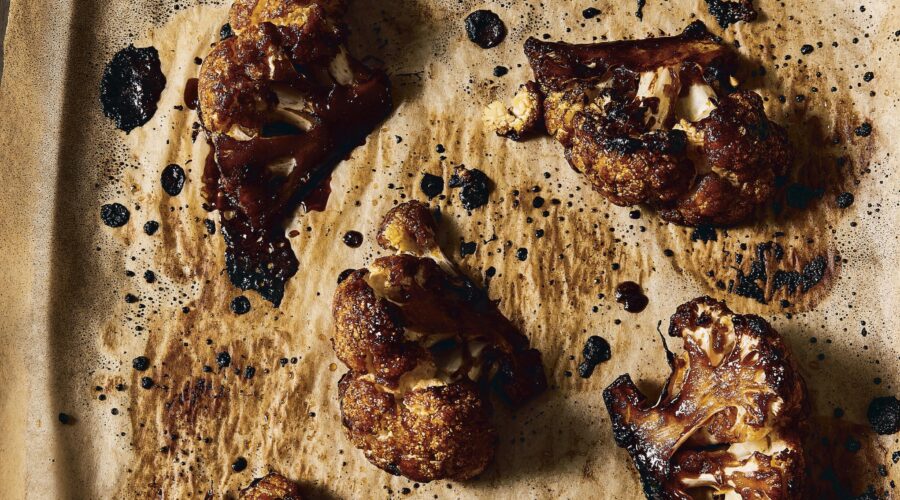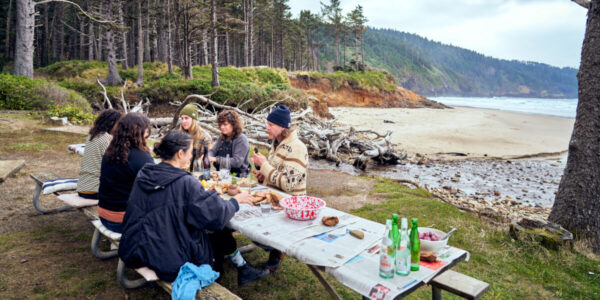Char Siu Roasted Cauliflower (Bông Cải Trắng Nướng vị Xá Xíu)

In tropical Vietnam, cauliflower is a prized cool-weather crop that’s typically stir-fried, added to soup, or pickled. Home ovens are uncommon in Vietnam, so few people roast cauliflower. In my California kitchen, however, I coat cauliflower wedges in salty-sweet-spicy seasonings typically reserved for Cantonese-style char siu barbecue pork, and then high-heat roast them. The contours of the wedges caramelize here and there to develop a deep savoriness that evokes the prized edges and corners of char siu pork. Serve this cauliflower as a satisfying main dish or tuck it into bao and bánh mì.
This recipe, and others like it, can be found in the article “These Easy Healthy Vietnamese Recipes Will Elevate Your Weeknight Dinners.”
How to Make It
Cut the Cauliflower: Position a rack in the middle of the oven and preheat to 450°F. Line a rimmed baking sheet with parchment paper. Pull off or cut away large leaves from the cauliflower, saving them for soup or broth, if you like. Trim a slice from the core end, where it’s likely discolored. While holding the cauliflower at a comfortable angle, curved-side down, insert your knife tip into the core. As you push the knife in farther, gently rock the blade side to side and back and forth. In a few seconds, the cauliflower head should crack and naturally break into two halves (mine are always uneven). Now cut each half into 4 wedges, each no thicker than 3 inches on the uneven floret side. (Hold the cauliflower flat-side or curved-side down, whichever is more comfortable. Cut an additional wedge only if you must.) Using a dish towel, dry the wedges so they’ll absorb the seasonings well.
Season: In a big bowl, stir together the hoisin sauce, sesame oil, agave syrup, ketchup, soy sauce, garlic, and five-spice powder. Add the cauliflower wedges and, using a big spoon or spatula, stir to coat well. Most of the seasonings should adhere. Spread the wedges out onto the prepared baking sheet, cut-side down. Drizzle or smear any remaining seasoning from the bowl onto the wedges.
Roast: Roast the cauliflower for 15 minutes, use tongs to turn over the wedges, and then roast 10 minutes longer. Liquid will appear on the pan. Continue roasting 10–15 minutes, during which the liquid will concentrate, bubble, and thicken. As that happens, use the tongs or a spatula to flip the cauliflower pieces about three times so they pick up the seasonings. When done, the cauliflower should look richly browned and be tender yet slightly chewy. A knife tip pierced into the thickest core areas usually meets a little resistance. The total roasting time is about 40 minutes. To get a slightly deeper color and flavor, keep the baking sheet in place and switch on the broiler for about 60 seconds, monitoring carefully to avoid burning. Remove the cauliflower from the oven and let it rest a few minutes to develop flavor before serving.
Ingredients
Directions
Cut the Cauliflower: Position a rack in the middle of the oven and preheat to 450°F. Line a rimmed baking sheet with parchment paper. Pull off or cut away large leaves from the cauliflower, saving them for soup or broth, if you like. Trim a slice from the core end, where it’s likely discolored. While holding the cauliflower at a comfortable angle, curved-side down, insert your knife tip into the core. As you push the knife in farther, gently rock the blade side to side and back and forth. In a few seconds, the cauliflower head should crack and naturally break into two halves (mine are always uneven). Now cut each half into 4 wedges, each no thicker than 3 inches on the uneven floret side. (Hold the cauliflower flat-side or curved-side down, whichever is more comfortable. Cut an additional wedge only if you must.) Using a dish towel, dry the wedges so they’ll absorb the seasonings well.
Season: In a big bowl, stir together the hoisin sauce, sesame oil, agave syrup, ketchup, soy sauce, garlic, and five-spice powder. Add the cauliflower wedges and, using a big spoon or spatula, stir to coat well. Most of the seasonings should adhere. Spread the wedges out onto the prepared baking sheet, cut-side down. Drizzle or smear any remaining seasoning from the bowl onto the wedges.
Roast: Roast the cauliflower for 15 minutes, use tongs to turn over the wedges, and then roast 10 minutes longer. Liquid will appear on the pan. Continue roasting 10–15 minutes, during which the liquid will concentrate, bubble, and thicken. As that happens, use the tongs or a spatula to flip the cauliflower pieces about three times so they pick up the seasonings. When done, the cauliflower should look richly browned and be tender yet slightly chewy. A knife tip pierced into the thickest core areas usually meets a little resistance. The total roasting time is about 40 minutes. To get a slightly deeper color and flavor, keep the baking sheet in place and switch on the broiler for about 60 seconds, monitoring carefully to avoid burning. Remove the cauliflower from the oven and let it rest a few minutes to develop flavor before serving.

